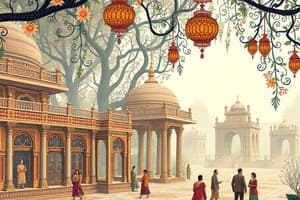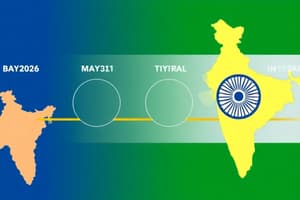Podcast
Questions and Answers
Which of the following best describes the economic system India adopted after independence?
Which of the following best describes the economic system India adopted after independence?
- A fully capitalist economy with minimal government intervention.
- A mixed economy combining elements of socialism and capitalism. (correct)
- A purely socialist economy with complete state control.
- An agrarian economy focused primarily on agricultural development.
What was a common underlying goal of India's Five Year Plans?
What was a common underlying goal of India's Five Year Plans?
- Prioritizing equity while disregarding economic growth.
- Focusing exclusively on industrial output and exports.
- Maximizing imports to boost technological advancements.
- Achieving growth, modernization, self-sufficiency, and equity. (correct)
What was the primary aim of land reforms implemented in the agriculture sector?
What was the primary aim of land reforms implemented in the agriculture sector?
- To redistribute land to promote equity and improve agricultural productivity. (correct)
- To encourage the conversion of agricultural land for industrial purposes.
- To consolidate land holdings for easier management by large corporations.
- To facilitate the privatization of all agricultural land.
How did the Green Revolution primarily benefit Indian farmers?
How did the Green Revolution primarily benefit Indian farmers?
What was a major drawback of the public sector's role in industrial development during the planning period?
What was a major drawback of the public sector's role in industrial development during the planning period?
What does the planning objective of 'growth with equity' primarily emphasize?
What does the planning objective of 'growth with equity' primarily emphasize?
How did the import substitution policy aim to impact India's industrial sector?
How did the import substitution policy aim to impact India's industrial sector?
The Green Revolution enabled the government to build stocks. How did these stocks benefit the country?
The Green Revolution enabled the government to build stocks. How did these stocks benefit the country?
In the context of India's economic planning from 1950-1990, which question reflects resource allocation?
In the context of India's economic planning from 1950-1990, which question reflects resource allocation?
What fundamental decision regarding production methods did India face during its early planning period (1950-1990)?
What fundamental decision regarding production methods did India face during its early planning period (1950-1990)?
If a farming family adopts new irrigation technology that substantially increases their marketable surplus of crops, what broader economic impact might this have?
If a farming family adopts new irrigation technology that substantially increases their marketable surplus of crops, what broader economic impact might this have?
What is one likely consequence of a significant shift in India's occupational structure away from agriculture and towards industry and services?
What is one likely consequence of a significant shift in India's occupational structure away from agriculture and towards industry and services?
What is a potential drawback of government subsidies in agriculture?
What is a potential drawback of government subsidies in agriculture?
Suppose India decides to liberalize its trade policies in the agricultural sector. Which outcome is LEAST likely?
Suppose India decides to liberalize its trade policies in the agricultural sector. Which outcome is LEAST likely?
If India aims to promote both industrial growth and agricultural productivity, which policy would be MOST effective?
If India aims to promote both industrial growth and agricultural productivity, which policy would be MOST effective?
What is the most direct implication of prioritizing capital-intensive production (more machines, less labor) in industry?
What is the most direct implication of prioritizing capital-intensive production (more machines, less labor) in industry?
Flashcards
Mixed Economy
Mixed Economy
An economic system combining socialism and capitalism.
Five Year Plans
Five Year Plans
Planned economic initiatives outlined every five years in India.
Green Revolution
Green Revolution
Agricultural initiative to improve food grain production using technology.
Land Reforms
Land Reforms
Signup and view all the flashcards
Self-sufficiency
Self-sufficiency
Signup and view all the flashcards
High Yielding Variety (HYV) Seeds
High Yielding Variety (HYV) Seeds
Signup and view all the flashcards
Marketable Surplus
Marketable Surplus
Signup and view all the flashcards
Public Sector
Public Sector
Signup and view all the flashcards
India's Five Year Plans
India's Five Year Plans
Signup and view all the flashcards
Goals of Five Year Plans
Goals of Five Year Plans
Signup and view all the flashcards
Regulated Economy
Regulated Economy
Signup and view all the flashcards
Agriculture Studies
Agriculture Studies
Signup and view all the flashcards
Occupational Structure
Occupational Structure
Signup and view all the flashcards
Agricultural Subsidies
Agricultural Subsidies
Signup and view all the flashcards
International Economic Organizations
International Economic Organizations
Signup and view all the flashcards
Merits and Limitations
Merits and Limitations
Signup and view all the flashcards
Study Notes
Indian Economy 1950-1990
- Learners will understand India's five-year plans' goals
- Students will learn about agricultural and industrial development policies during 1950-1990
- Learners will gain insight into the merits and limitations of a regulated economy.
Introduction
- On August 15, 1947, India gained freedom
- Nation-building task was the new responsibility
- Leaders sought an economic system that promoted overall welfare
- Jawaharlal Nehru favoured socialism but rejected the Soviet Union's approach
- The new leaders aimed for an alternative to strict capitalism and socialism, favouring a blended approach.
Types of Economic Systems
- Societies address three key questions: goods/services production, production methods and distribution.
- In a market/capitalist economy, supply/demand dictate production and distribution based on consumer purchasing power.
- Socialist economies dictate production/distribution based on societal needs
- Mixed economies adopt both government and market-driven systems.
What is a Plan?
- A plan outlines a nation's resource allocation, setting general goals and specific, time-bound objectives.
- Plans in India were five-year plans, initially borrowed from the Soviet Union's experience
- Plans should not contradict their key goals, including growth, modernisation, self-reliance and equity
- These goals may differ in importance within different plans.
The Service Sector
- As countries develop, the agricultural sector's share decreases, and the industrial and service sectors increase.
- In India's case, the service sector's share exceeded that of agriculture/industry by 1990
- The rise of the service sector coincided with globalization
Mahalanobis: The Architect of Indian Planning
- Prasanta Chandra Mahalanobis was a significant statistician
- He played a pivotal role in shaping Indian planning, particularly during the Second Five-Year Plan.
Land Reforms
- Land-to-the-tiller policy aims for greater cultivator interest in output
- Land reforms aimed to reduce land concentration through ownership redistribution and fixing maximum landholdings.
The Green Revolution
- Increased food production through high-yielding variety (HYV) seeds
- This involved fertilisers, pesticides, and irrigation improvements
- The revolution primarily benefited more affluent states initially, then spread gradually.
The Debate over Subsidies
- The debate on agricultural subsidies' worthiness centres on whether to continue them for efficiency and equity.
- Experts argue over whether subsidies disproportionately benefit large farmers or poor farmers while also being a burden on the government's finances.
Trade Policy: Import Substitution
- Import substitution policies promoted domestic production to reduce reliance on foreign imports
- Tariffs and quotas helped protect domestic industries from foreign competition
- The focus on import substitution had intended positive outcomes from an economic development perspective, but also presented some setbacks.
Effects of Policies on Industrial Development
- India's industrial sector experienced significant growth, with its share of GDP increasing significantly
- Policies aimed to promote industrial growth in both large and small industries.
Public and Private Sectors
- The debate over the proper role of the government versus the private sector in development efforts was evident.
- Arguments for a prominent role for the public sector in key industries were commonly heard, while certain private sector industries could not generate enough investment in order to grow
Conclusion
- India's economic progress during its first seven five-year plans was impressive, with diversification and self-sufficiency achievements
- The green revolution had a significant impact on agriculture
- The need for reforms in economic policies and a more global approach to trade and economic production models is a recurring theme in the conclusion.
Studying That Suits You
Use AI to generate personalized quizzes and flashcards to suit your learning preferences.




